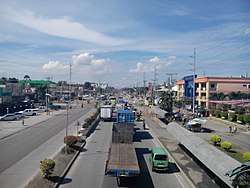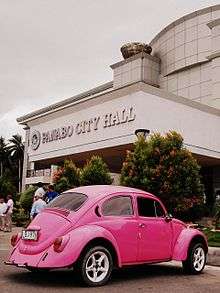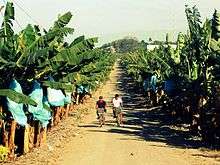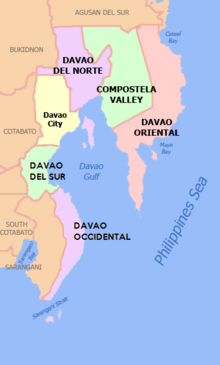Panabo
| Panabo | ||
|---|---|---|
| Component City | ||
| City of Panabo | ||
 Downtown area | ||
| ||
| Nickname(s): Banana Capital of the Philippines | ||
 Map of Davao del Norte with Panabo highlighted | ||
.svg.png) Panabo Location within the Philippines | ||
| Coordinates: 7°18′N 125°41′E / 7.3°N 125.68°ECoordinates: 7°18′N 125°41′E / 7.3°N 125.68°E | ||
| Country |
| |
| Region | Davao Region (Region XI) | |
| Province | Davao del Norte | |
| District | 2nd District | |
| Founded | July 19, 1949 | |
| Cityhood | March 31, 2001 | |
| Barangays | 40 (see Barangays) | |
| Government [1] | ||
| • Type | Sangguniang Panlungsod | |
| • Mayor | James G. Gamao | |
| • Vice Mayor | Janrey G. Gavina | |
| • Electorate | 96,662 voters (2016) | |
| Area [2] | ||
| • Total | 251.23 km2 (97.00 sq mi) | |
| Population (2015 census)[3] | ||
| • Total | 184,599 | |
| • Density | 730/km2 (1,900/sq mi) | |
| Time zone | UTC+8 (PST) | |
| ZIP code | 8105 | |
| PSGC | 112315000 | |
| IDD : area code | +63 (0)84 | |
| Climate type | Tropical rainforest climate | |
| Income class | 3rd city income class | |
| Revenue (₱) | 812,896,522.17 (2016) | |
| Native languages |
Ata Manobo Davawenyo Cebuano Kalagan language Tagalog | |
| Website |
www | |
Panabo, officially the City of Panabo, or simply referred to as Panabo City is a 3rd class city in the province of Davao del Norte, Philippines. According to the 2015 census, it has a population of 184,599 people.[3]
Bordering Davao City to its northeast, Panabo is a part of Davao Metropolitan Area. The city has an area of 25,123 hectares (62,080 acres).
Government
The Panabo City Hall is located about 2.23 kilometers from its boundary with Davao City.
Barangays
The city is politically subdivided into 40 barangays. Quezon was formerly the sitio of Cabili; it became a barrio in 1957.[4]
- A. O. Floirendo
- Datu Abdul Dadia
- Buenavista
- Cacao
- Cagangohan
- Consolacion
- Dapco
- Gredu (Poblacion)
- J.P. Laurel
- Kasilak
- Katipunan
- Katualan
- Kauswagan
- Kiotoy
- Little Panay
- Lower Panaga (Roxas)
- Mabunao
- Maduao
- Malativas
- Manay
- Nanyo
- New Malaga (Dalisay)
- New Malitbog
- New Pandan (Pob.
- New Visayas
- Quezon
- Salvacion
- San Francisco (Poblacion)
- San Nicolas
- San Pedro
- San Roque
- San Vicente
- Santa Cruz
- Santo Niño (Poblacion)
- Sindaton
- Southern Davao
- Tagpore
- Tibungol
- Upper Licanan
- Waterfall
History
Originally the rich lowland was inhabited by a group of stocky-haired natives called Aetas. These people led nomadic life and lived by hunting. With the use of their most essential tool, the bow and arrow—"pana-sa-boboy" as they call it—they hunted for food which primarily consisted of rootcrops and meat of wild boars.[5]
When the Christian settlers came at the beginning of the 20th century, the place was already a thriving trading community; thus, the place was already known as Taboan, which means "trading center". After the Cristian settlers began pioneering the region, the natives moved further to the hinterlands along with them their "pana-sa-boboy". This term later evolved into present day name Panabo.[5]
Legal Basis
Panabo, which was formerly a mere barangay of Tagum, then known as Magugpo during that time, became a town July 19, 1949, through Presidential Proclamation No. 236 of the President Manuel A. Roxas.
The local government unit of Panabo was created into a component city of Davao del Norte by virtue of Republic Act No. 9015 and ratified by the residents in a plebiscite held on March 31, 2001. However, its official existence as a municipal corporation took effect on with the appointment of new set of officials.

Demographics
| Population census of Panabo | ||
|---|---|---|
| Year | Pop. | ±% p.a. |
| 1960 | 42,509 | — |
| 1970 | 42,920 | +0.10% |
| 1975 | 53,015 | +4.33% |
| 1980 | 71,098 | +6.04% |
| 1990 | 110,172 | +4.48% |
| 1995 | 121,472 | +1.85% |
| 2000 | 133,950 | +2.12% |
| 2007 | 154,329 | +1.97% |
| 2010 | 174,364 | +4.54% |
| 2015 | 184,599 | +1.09% |
| Source: Philippine Statistics Authority [3][6][7][8] | ||
Economy

Being an agro-industrial city, Panabo is known as the "Banana Capital of the Philippines" due to numerous banana plantations scattered throughout the city. In fact, Panabo is the home of the world’s biggest banana plantation, which is owned by the Tagum Agricultural Development Company (TADECO), which covers around 6,900 hectares of banana fields and produce millions of boxes of export-quality bananas annually. The city itself cultivated 40% of its land or around 10,000 hectares into planting export-quality Cavendish bananas. Thus, banana cultivation and exportation are the main economic lifeblood of the city.
Infrastructure
There are also two privately owned port facilities in the city, which enabled them to export various fruits, such as bananas, mangoes, papayas, and pineapples, to countries like Japan, Korea, China, and countries as far in the Middle East and the European Union.
Public infrastructure includes the Freedom Park which features a unique banana inspired fountain sculpted by the world class artist Kublai Millan. The Panabo Multi-Purpose Cooperative Tourism Gymnasium, located beside the City Hall is also a public infrastructure, the gymnasium accommodates an estimated ten-thousand people and also serves as playing venue of the Philippine Basketball Association as well as serving concerts for the city.
Education
Universities:
- North Davao Colleges (private)
- University of Mindanao, Panabo College (private)
- Davao del Norte State College (public)
Colleges:
- ACES Polytechnic College of Panabo
- NorthLink Technological College, Inc.
- Valiant Technological College
- Northern Paramedical and Technological College
- East Asian College of Panabo
- The Leores Training Academy Inc.
High-schools:
- Davao del Norte State College Laboratory School (private)
- North Davao Colleges - High School Department (private)
- Maryknoll College of Panabo (private)
- Francisco Adlaon Learning Institute (private)
- Panabo SDA Learning Center (private)
- Panabo Christian School (private)
- Panabo Achievers Academy (2nd year only) (private)
- Panabo National High School (public)
- Little Panay National High School (Panabo National High School Annex)
- Colegio de Davao, Panabo City (Private)
- Good Shepherd Baptist School (Church School)
- A. O. Floirendo National High School
- Don M. Javellana National High School
- Kauswagan National High School
- Mabunao High School
- Malativas National High School
- Manay National High School
- San Vicente National High School (Panabo National High School Annex)
- Sindaton National High School
- Southern Davao National High School[9]
A memorandum of agreement between UP Los Baños College of Agriculture and ANFLOCOR was signed for the establishment of UP Professional School for Agriculture and the Environment (UP PSAE) which will be UPLB's extension campus in Panabo City.[10][11][12] In addition, UP Mindanao will also collaborate on some courses and programs to be offered.[13]
Sister Cities
- Within the Philippines
References
- ↑ "City". Quezon City, Philippines: Department of the Interior and Local Government. Retrieved 30 May 2013.
- ↑ "Province: Davao del Norte". PSGC Interactive. Quezon City, Philippines: Philippine Statistics Authority. Retrieved 12 November 2016.
- 1 2 3 Census of Population (2015). "Region XI (Davao Region)". Total Population by Province, City, Municipality and Barangay. PSA. Retrieved 20 June 2016.
- ↑ "An Act Converting the Sitio of Cabili, Municipality of Panabo, Province of Davao, into a Barrio of Said Municipality to Be Known As the Barrio of Quezon". LawPH.com. Retrieved 2011-04-12.
- 1 2 "City Profile". Local Government of Panabo City. Retrieved 30 April 2014.
- ↑ Census of Population and Housing (2010). "Region XI (Davao Region)". Total Population by Province, City, Municipality and Barangay. NSO. Retrieved 29 June 2016.
- ↑ Censuses of Population (1903–2007). "Region XI (Davao Region)". Table 1. Population Enumerated in Various Censuses by Province/Highly Urbanized City: 1903 to 2007. NSO.
- ↑ "Province of Davao del Norte". Municipality Population Data. Local Water Utilities Administration Research Division. Retrieved 17 December 2016.
- ↑ http://philippines-schools.blogspot.com/2012/07/panabo-city-public-high-school.html
- ↑ http://www.uplb.edu.ph/380-up-anflocor-signs-moa-to-develop-the-up-prof-l-school-in-davao
- ↑ http://uplb.edu.ph/383-at-its-108th-foundation-day-uplb-s-harvest-for-2017-a-refocused-cafs-a-davao-campus-best-personnel
- ↑ http://davaotoday.com/main/economy/education/uplb-to-put-up-satellite-campus-in-panabo-city/
- ↑ http://alum.up.edu.ph/?p=3590
External links
| Wikivoyage has a travel guide for Panabo. |
| Wikimedia Commons has media related to Panabo City. |

